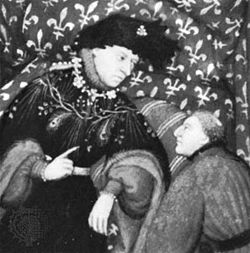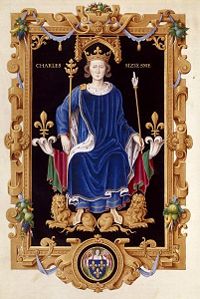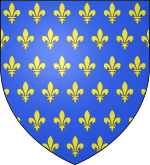Charles VI of France
| Charles VI the Mad | |
|---|---|
| King of France (more...) | |
 |
|
| Reign | 16 September 1380 – 21 October 1422 |
| Coronation | 4 November 1380 |
| Predecessor | Charles V |
| Successor | Charles VII |
| Consort | Isabeau of Bavaria |
| Issue | |
| Isabelle, Queen of England Louis, Dauphin of Viennois John, Dauphin of Viennois Michelle of Valois Catherine, Queen of England Charles VII |
|
| Royal house | House of Valois |
| Father | Charles V |
| Mother | Joanna of Bourbon |
| Born | 3 December 1368 Paris, France |
| Died | 21 October 1422 (aged 53) Paris, France |
| Burial | Saint Denis Basilica |
Charles VI (3 December 1368 – 21 October 1422), called the Well-loved (French: le Bien-Aimé) and the Mad (French:le Fol or le Fou), was the King of France from 1380 to 1399, as a member of the House of Valois.
Contents |
Early life

He was born in Paris, the son of King Charles V and Jeanne de Bourbon. At the age of eleven, he was crowned King of France in 1380 in the cathedral at Reims. He married Isabeau of Bavaria in 1385. Until he took complete charge as king in 1388, France was ruled primarily by his uncle, Philip the Bold.
Charles VI was known both as Charles the Well-loved and later as Charles the Mad, since, beginning in his mid-twenties, he experienced bouts of psychosis. These fits of madness would recur for the rest of his life. Based on his symptoms, he probably suffered from schizophrenia.
Madness

Charles's first known fit occurred in 1392 when his friend and advisor, Olivier de Clisson, was the victim of an attempted murder. Although Clisson survived, Charles was determined to punish the would-be assassin Pierre de Craon who had taken refuge in Brittany. Contemporaries said Charles appeared to be in a "fever" to begin the campaign and appeared disconnected in his speech. Charles set off with an army on 1 July 1392. The progress of the army was slow, nearly driving Charles into a frenzy of impatience.
While travelling through a forest on a hot August morning, a barefoot man dressed in rags rushed up to the King's horse and grabbed his bridle. "Ride no further, noble King!" he yelled. "Turn back! You are betrayed!" The king's escorts beat the man back but did not arrest him, and he followed the procession for a half-hour, repeating his cries.
The company emerged from the forest at noon. A page who was drowsy from the sun dropped the king's lance, which clanged loudly against a steel helmet carried by another page. Charles shuddered, drew his sword and yelled "Forward against the traitors! They wish to deliver me to the enemy!" The king spurred his horse and began swinging his sword at his companions, fighting until one of his chamberlains and a group of soldiers were able to grab him from his mount and lay him on the ground. He lay still and did not react, falling into a coma. The king killed a knight named the bastard of Polignac and several other men (the exact number of victims differs in the chronicles from the time).
The king continued to suffer from periods of mental illness throughout his life. During one attack in 1393, Charles could not remember his name and did not know he was king, and when his wife came to visit he asked his servants who she was and ordered them to take care of whatever she required so that she would leave him alone.[1] During an episode of 1395-1396, he claimed that his name was George and that his coat of arms was a lion with a sword thrust through it.[2] At this time, he recognized all the officers of his household but did not know his wife or his children. Sometimes he ran wildly through the corridors of his Parisian residence, the Hôtel Saint-Pol, and to keep him inside the entrances were walled up. In 1405 he refused to bathe or change his clothes for five months.[3] His later psychotic episodes were not described in detail probably because of the similarity of his behavior and delusions. Pope Pius II, who was born in the middle of the reign of Charles VI, wrote in his Commentaries that there were times when Charles thought that he was made of glass, and this caused him to protect himself in various ways so that he would not break.[4]
The Bal des Ardents

In January 1393, Queen Isabeau de Bavière organized a party to celebrate the marriage of one of her ladies-in-waiting. The King and five other lords dressed up as wild men and danced about chained to one another. They were "in costumes of linen cloth sewn onto their bodies and soaked in resinous wax or pitch to hold a covering of frazzled hemp, so that they appeared shaggy & hairy from head to foot".[5] In view of the obvious danger of fire, the torch-bearers were told to stand at the side of the room. Nonetheless, the King's brother, Louis of Valois, Duke of Orléans, who had arrived late, approached with a lighted torch in order to discover the identity of the masqueraders, and he accidentally lit one of them on fire. There was panic as the fire spread. The Duchess of Berry, to save a dancer who had come near her to intrigue and tease her, threw the train of her gown over him, and it was soon revealed to her that the life she had saved was the king's.[6] Four of the other men perished. This incident became known as the Bal des Ardents (the "Ball of the Burning Men".)
Struggles for power
With the King mad, his uncles Philip the Bold, Duke of Burgundy, John, Duke of Berry and Louis, Duke of Anjou took control and dismissed Charles's advisers and various other officials he had appointed. This was to be the start of a series of major feuds among the princes of royal blood which would cause much chaos and conflict in France even beyond Charles's reign.
|
|||||||||||||||||||||||||||||
Allegations of an affair between Charles' brother, Louis Duke of Orléans, and Queen Isabeau were soon spreading. As a result, the legitimacy of her children, especially the heir to the throne, was often questioned. Furthermore, the Duke of Burgundy accused Louis of wasting state money on personal pleasures rather than on supporting or defending the realm.
Philip the Bold's death in April 1404 did not bring an end to Louis' problems. John the Fearless, the new Duke of Burgundy took over and the feud escalated. In 1407 the Duke of Orléans was murdered in the streets of Paris. John did not deny responsibility, claiming that Louis was a tyrant who scandered money.
Louis' son, Charles, new Duke of Orléans, turned to his father-in-law, Bernard VII, Count of Armagnac, for support. This resulted in the Armagnac-Burgundian Civil War.
Charles VI's secretary Pierre Salmon spent much time in discussions with the king while he was suffering from his intermittent but incapacitating psychosis. In an effort to find a cure for the king's illness, stabilize the turbulent political situation, and secure his own future, Salmon supervised the production of two distinct versions of the beautifully illuminated guidebooks to good kingship known as Pierre Salmon's Dialogues.
The English invasion
Charles VI's reign was marked by the continuing war with the English known as the Hundred Years' War. An early attempt at peace occurred in 1396 when Charles' daughter, the not quite seven-year-old Isabella of Valois, married the 29-year-old Richard II of England.
The feud between the Royal family and the house of Burgundy led to chaos and anarchy. Taking advantage, Henry V of England led an invasion which culminated in October 1415 when the French army was defeated at the Battle of Agincourt.
With the English taking over the country, John the Fearless sought to end the feud with the Royal family by negotiating with the Dauphin, the King's heir. They met at the bridge at Montereau on the 10th of September 1419 but in the course of the meeting the Duke was killed by Tanneguy du Châtel, a follower of the Dauphin. John's successor, Philip the Good, threw in his lot with the English.
(Philip the Good would later make peace with the Dauphin, now Charles VII, with the Treaty of Arras when, under the inspiration of Joan of Arc, the tide of the war turned in favour of the French side. Joan was burned at the stake when Burgundy handed her over to the English.)
In 1420, King Charles signed the Treaty of Troyes which recognized Henry of England as his successor, disinherited his son the Dauphin Charles, and betrothed his daughter, Catherine of Valois, to Henry (see English Kings of France).
Many historians have misinterpreted this treaty and the disinheriting of the Dauphin Charles. The Dauphin sealed his fate, in the eyes of the king, by committing treason: he declared himself regent, usurping royal authority, and refused to obey the king's order to return to Paris.[7] It is important to remember that when the Treaty of Troyes was finalized in May 1420, the Dauphin Charles was only 17 years old. He was a weak figure who was easily manipulated by his advisors and even his own mother despised him.
Charles VI died in 1422 at Paris and is interred with his wife Isabeau de Bavière in Saint Denis Basilica. Both their grandson, the one-year-old Henry VI of England, and their son, Charles VII, were proclaimed King of France, but it was the latter who finally became the actual ruler with the support of Joan of Arc.
Charles VI appeared to have passed on his mental illness to his grandson Henry, whose inability to govern England led to the Wars of the Roses.
Ancestors
| Charles VI of France | Father: Charles V of France |
Paternal Grandfather: John II of France |
Paternal Great-grandfather: Philip VI of France |
| Paternal Great-grandmother: Joan of Burgundy |
|||
| Paternal Grandmother: Bonne of Bohemia |
Paternal Great-grandfather: John I of Bohemia |
||
| Paternal Great-grandmother: Elisabeth I of Bohemia |
|||
| Mother: Joanna of Bourbon |
Maternal Grandfather: Peter I, Duke of Bourbon |
Maternal Great-grandfather: Louis I, Duke of Bourbon |
|
| Maternal Great-grandmother: Mary of Avesnes |
|||
| Maternal Grandmother: Isabella of Valois |
Maternal Great-grandfather: Charles of Valois |
||
| Maternal Great-grandmother: Mahaut of Chatillon |
Marriage and Issue
Charles VI married:
Isabeau of Bavaria (ca. 1371 – 24 September 1435) on 17 July 1385.
| Name | Birth | Death | Notes |
|---|---|---|---|
| Charles, Dauphin | 25 September 1386 | 28 December 1386 | Died young. First Dauphin. |
| Joan | 14 June 1388 | 1390 | Died young. |
| Isabella | 9 November 1389 | 13 September 1409 | Married (1) Richard II, King of England (1367 - 1400) in 1396. No issue. Married (2) Charles, Duke of Orleans (1394 - 1465) in 1406. Had issue. |
| Joan | 24 January 1391 | 27 September 1433 | Married John VI, Duke of Brittany (1389 - 1442) in 1396. Had issue. |
| Charles of France, Dauphin | 6 February 1392 | 13 January , 1401 | Died young. Second Dauphin. |
| Mary | 22 August 1393 | 19 August 1438 | Never married - became an abbess. No issue. Died of the Plague |
| Michelle | 11 January 1395 | 8 July 1422 | Married Philip the Good, Duke of Burgundy (1396 - 1467) in 1409. |
| Louis, Dauphin | 22 January 1397 | 18 December 1415 | Married Margaret of Burgundy. Third Dauphin. |
| John, Dauphin | 31 August 1398 | 5 April 1417 | Married Jacqueline, Countess of Hainaut (1401 - 1436) in 1415. No issue. Fourth Dauphin. |
| Catherine | 27 October 1401 | 3 January 1438 | Married (1) Henry V, King of England (1387 - 1422) in 1420. Had issue. Married (?) (2) Owen Tudor (1400 - 1461). Had issue. |
| Charles VII, King of France | 22 February 1403 | 21 July 1461 | Married Marie of Anjou (1404 - 1463) in 1422. Had issue. The fifth Dauphin. |
| Philip | 10 November 1407 | 10 November 1407 | Died young. |
He also had one illegitimate child by Odette de Champdivers, Marguerite bâtarde de France (d. ca.1458).
Cultural References
The novel The Notebooks of Malte Laurids Brigge by Rainer Maria Rilke describes the old age of Charles VI at length.
The story "Hop-Frog, or The Eight Chained Ourang-Outangs" by Edgar Allan Poe involves a scene strikingly similar to the Bal des Ardents. (Full text at Wikisource)
The Edith Pattou novel East mentions Charles of France's second son, Charles, to be the white bear.
King Charles VI, and his madness, are mentioned at length in the historical novel Het Woud der Verwachting/Le Foret de Longue Attente/In a Dark Wood Wandering (1949) by Hella S. Haasse.
References
- ↑ R.C. Famiglietti, Royal Intrigue: Crisis at the Court of Charles VI, 1392-1420, New York, 1986, p. 4, citing the chronicle of the Religieux de Saint-Denis, ed. Bellaguet, II, pp. 86-88.
- ↑ R.C. Famiglietti, Royal Intrigue: Crisis at the Court of Charles VI, 1392-1420, New York, 1986, p. 5, citing the chronicle of the Religieux de Saint-Denis, ed. Bellaguet, II, pp. 404-05.
- ↑ R.C. Famiglietti, Royal Intrigue: Crisis at the Court of Charles VI, 1392-1420, New York, 1986, p. 6, citing the chronicle of the Religieux de Saint-Denis, ed. Bellaguet, III, p. 348
- ↑ Enea Silvio Piccolomini (Papa Pio II), I Commentarii, ed. L. Totaro, Milano, 1984, I, p. 1056.
- ↑ Barbara Tuchman, A Distant Mirror,1978, Alfred A Knopf Ltd. See the chronicle of the Religieux de Saint-Denis, ed. Bellaguet, II, pp. 64-71.
- ↑ Chronicles ... by Sir John Froissart, ed. T. Johnes, II (1855), pp. 550-52
- ↑ R.C. Famiglietti, Royal Intrigue: Crisis at the Court of Charles VI, 1392-1420, New York, 1986, Chapter X.
Sources
- Famiglietti, R.C., Royal Intrigue: Crisis at the Court of Charles VI, 1392-1420, New York; AMS Press, 1986.
- Famiglietti, R.C., Tales of the Marriage Bed from Medieval France (1300-1500), Providence; Picardy Press, 1992.
- Tuchman, Barbara, A Distant Mirror: The Calamitous 14th Century, New York; Ballantine Books, 1978.
|
Charles VI of France
House of Valois
Cadet branch of the Capetian dynasty
Born: 3 December 1368 Died: 21 October 1422 |
||
| Preceded by Charles I of Viennois |
Dauphin of Viennois, Count of Valentinois and of Diois as 'Charles II' 3 December 1368–16 September 1380 |
Succeeded by Himself as King of France |
| French nobility | ||
|---|---|---|
| Preceded by Vacant (John, 2nd Dauphin) |
Dauphin of France as 'Charles, 3rd Dauphin' 3 December 1368–16 September 1380 |
Succeeded by Vacant (eventually Charles, 4th Dauphin) |
| Regnal titles | ||
| Preceded by Charles V |
King of France 16 September 1380–21 October 1422 |
Succeeded by Charles VII of France and Henry VI of England |
| Preceded by Himself as Dauphin of France |
Dauphin of Viennois, Count of Valentinois and of Diois as 'Charles II of Viennois' 16 September 1380–26 September 1386; 28 December 1386–6 February 1392 |
Succeeded by Charles III of Viennois |
| Preceded by Charles III of Viennois |
Succeeded by Charles IV of Viennois |
|
|
|||||||||||||||||||||||||||||||||||
